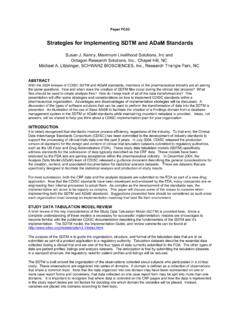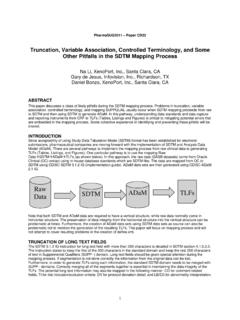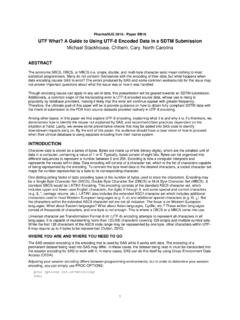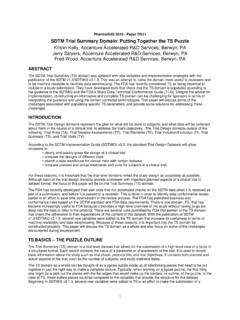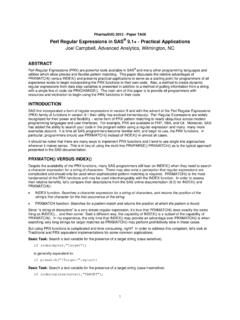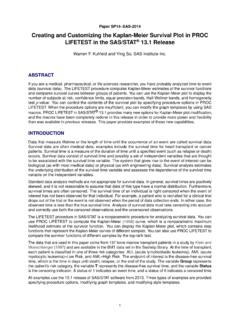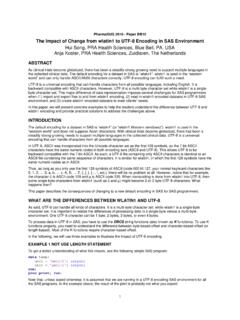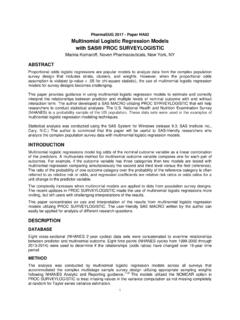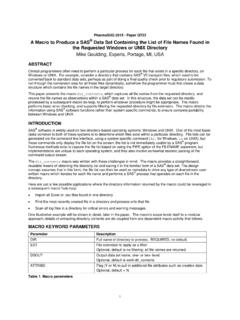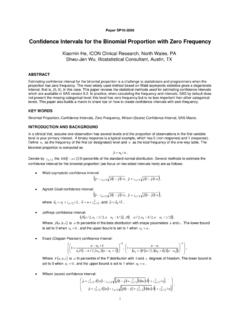Transcription of Transforming Biomarker Data into an SDTM based Dataset
1 PharmaSUG 2016 Paper DS15. Transforming Biomarker data into an sdtm based Dataset Kiran Cherukuri, Seattle Genetics, Inc., Bothell, WA. ABSTRACT. biomarkers play an increasingly important role in drug discovery and development. They are used as a tool for understanding the mechanism of action of a drug, investigating efficacy and toxicity signals at an early stage of pharmaceutical development, and in identifying patients likely to respond to a treatment. This paper provides an Introduction to the implementation of sdtm standards for data that defines a genetic Biomarker and data about genetic observations. The draft CDISC sdtm Pharmacogenomics/Genetics implementation Guidance will be referenced and rationale for using specific aspects of the draft guidance or suggesting a modification will be explained.
2 The variables used, considerations taken and the process for setting up the pharmacogenomics/ genetics Biomarker domains will be described. INTRODUCTION. Study data Tabulation Model ( sdtm ) provides a general framework for describing the organization of data collected during clinical trials. This framework is described in sdtm implementation Guide (SDTMIG) and includes details about the common types of data for each of the basic structures defined in sdtm . One of the reasons to convert legacy data or data in non-standard format to CDISC sdtm format is to provide Case Report Tabulation (CRT) data to a regulatory agency, such as the FDA. This standardized format used with available software tools will allow efficient access and correct interpretation of the data submitted.
3 This will also help in efficiently preparing for Integrated Summaries of Safety and Efficacy (ISS/ ISE). Incorporating Pharmacogenomics and pharmacogenetics data that is obtained in clinical trials by testing biological samples collected from the patient and the results of which may have implications for the subject or for a drug is not addressed in the approved SDTMIG. Recently, CDISC PGx team came up with draft guidance SDTMIG for Pharmacogenomics/ Genetics (SDTMIG-PGx) that provides some direction to sponsors. This paper mainly discusses, What a Biomarker is, Significance of biomarkers in clinical trials, And, introduces the domains defined in SDTMIG- PGx and describes how the data collected fits into the defined domains and what challenges were faced to incorporate certain Biomarker data into sdtm format.
4 What is a Biomarker ? Biological Markers, commonly called biomarkers are any signs of biological process that can be objectively measured. A biological process can be something that is normally happening in the body or during a development of a disease or in response to drug in a patient undergoing treatment. biomarkers indicate when and to what extent a physiological or biological process has taken place in the body of a person. Thus, they can be used for both in diagnosis and for monitoring a success of a therapy. The National Institutes of Health biomarkers Definitions Working Group defined a Biomarker as a characteristic that is objectively measured and evaluated as an indicator of normal biological processes, pathogenic processes, or pharmacologic responses to a therapeutic intervention'.
5 World Health Organization (WHO) in coordination with the United Nations and the International Labor Organization, has defined a Biomarker as any substance, structure, or process that can be measured in the body or its products and influence or predict the incidence of outcome or disease . A Biomarker can be a gene, molecule, enzyme, specific cell or a protein. Examples of biomarkers include everything from pulse and blood pressure, an antibody, a presence of a certain genetic mutation in the DNA of the cancer cell, electrocardiographic testing, and image information such as computed tomography (CT), magnetic resonance imaging (MRI) and positron-emission tomography (PET). Significance of biomarkers in Clinical Trials Prior to the introduction of biomarkers , treatment choices were traditionally made based on a patient's medical history and pathology.
6 Possible influences on drug response that are usually considered when making treatment decisions or drug adjustments include age, sex, disease, environmental factors, diet, and drug interactions. However, even when these factors are taken into account, drug response often varies among patients, ranging from positive outcomes to fatal adverse reactions. The reason being, most of the therapies are developed to treat all patients with the same clinical diagnosis; One size fits all . Many therapies only work in a fraction of the patients for which they are prescribed. Even though these therapies work, a significant progress can be made by getting the right treatment to the right person. With the help of discovering, confirming and clinically validating biomarkers this can be achieved.
7 In drug discovery and development, biomarkers of all types play a big role; the use of biomarkers in clinical development delivers information on the efficacy and safety of the treatment and ideally indicates which patients benefit from a potential drug. biomarkers play a critical role in improving the drug development process both in Early and Late phase clinical trials. The purpose of Biomarker data in early phase clinical trials is to support proof of concept, dose selection and as go/no-go decision-making tool. In late phase clinical trials, disease biomarkers or pharmacogenomics biomarkers help provide better understanding of inter-patient variability in response. In oncology , biomarkers are used to provide information of a person's risk of developing cancer and to determine their prognosis once a cancer is diagnosed and, in some cases to predict how a patient responds to a particular medications.
8 In relation to the treatment of cancer, biomarkers fall into two main classes: Prognostic biomarkers : These biomarkers provide information about how the disease is likely to progresses. Including how long the patient is expected to live. This determines how aggressively the patient needs to be treated. Predictive biomarkers : These biomarkers help to determine which patients are more appropriate candidates to receive a treatment; this lets the physicians to choose one treatment over another for the patient. Pharmacodynamic biomarkers : These biomarkers could be used as a parameter of the drug activity to demonstrate proof of principle and be used to optimize the dosing schedule of the drug during the earlier of the drug development program.
9 Pharmacodynamic: What dose? Drug metabolism Prognostic : Who needs Pharma toxicity: Treatment? Clinical Predictor of adverse Outcomes regardless of drug response therapy Efficacy Response: Predictive: Which drug Predictor of clinical Biomarker (or drugs)? Response outcome of response to targeted treatment Figure 1: Application of biomarkers in Clinical trials STUDY data TABULATION MODEL implementation GUIDE FOR. PHARMACOGENOMICS AND PHARMACOGENETICS (SDTMIG-PGx). Pharmacogenomics and pharmacogenetics both refer to the study of how the particulars of an individual's genetic sequences affect the response of the individual to drugs. The term pharmacogenetics is regarded as the study of genetic variation that gives rise to differing responses to drugs; and the term pharmacogenomics, is the genome-wide analysis of genetic determinants of drug-metabolizing enzymes, receptors, transporters, and targets that influence therapeutic efficacy and safety and drug-related phenotypes.
10 The purpose of the SDTMIG-PGx is to provide guidance on the implementation of the sdtm for biospecimen- and genetics-related data , including but not limited to: biospecimen collection and handling, genetic mutation, genotyping, gene expression, cytogenetics, viral genetics, and proteomics. The domains introduced in this document are intended to hold data that fall into one of three general categories: data about biospecimens, data about genetic observations, and data that define a genetic Biomarker or assign it to a subject. Figure 2: SDTMIG-PGx Domains and Datasets, Study data Tabulation Model implementation Guide: Pharmacogenomics/Genetics Version (Draft). BE Biospecimen Events Domain This Events class domain is used to capture information about actions taken that affect a specimen or alter its status.
